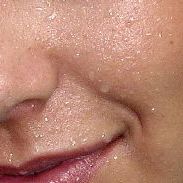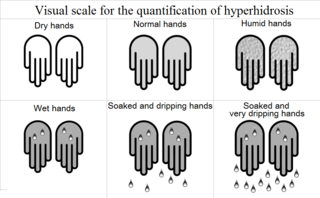
Perspiration, also known as sweating, is the production of fluids secreted by the sweat glands in the skin of mammals.
Electrology is the practice of electrical hair removal to permanently remove human hair from the body. Electrolysis is the actual process of removing hair using electricity.

Hives, also known as urticaria, is a kind of skin rash with red, raised, itchy bumps. They may also burn or sting. Often the patches of rash move around. Typically they last a few days and do not leave any long-lasting skin changes. Fewer than 5% of cases last for more than six weeks. The condition frequently recurs.

Cold urticaria is a disorder where hives (urticaria) or large red welts form on the skin after exposure to a cold stimulus. The welts are usually itchy and often the hands and feet will become itchy and swollen as well. Hives vary in size from about 7mm in diameter to as big as about 27mm diameter or larger. This disorder, or perhaps two disorders with the same clinical manifestations, can be inherited or acquired. The acquired form is most likely to occur between ages 18–25, although it can occur as early as 5 years old in some cases. Life-threatening risks include suffocation resulting from pharyngeal angiooedema induced by cold foods or beverages, drowning after shock from swimming in cold water and anaphylactic shock.

Dermatographic urticaria is a skin disorder and one of the most common types of urticaria, affecting 2–5% of the population.

Urticaria pigmentosa is the most common form of cutaneous mastocytosis. It is a rare disease caused by excessive numbers of mast cells in the skin that produce hives or lesions on the skin when irritated.
ICD-10 is an international statistical classification used in health care and related industries.

Solar urticaria (SU) is a rare condition in which exposure to ultraviolet or UV radiation, or sometimes even visible light, induces a case of urticaria or hives that can appear in both covered and uncovered areas of the skin. It is classified as a type of physical urticaria. The classification of disease types is somewhat controversial. One classification system distinguished various types of SU based on the wavelength of the radiation that causes the breakout; another classification system is based on the type of allergen that initiates a breakout.
Aquagenic urticaria, also known as water allergy and water urticaria, is a rarely diagnosed form of physical urticaria. The defining symptom is an itchy skin reaction resulting from contact with water, regardless of its temperature. It is sometimes described as an allergy, although it is not a true histamine-releasing allergic reaction like other forms of urticaria. This seems to not be affected by different temperatures of water, or chemicals such as fluorine and chlorine, since it is reproduced with distilled water and medical saline.
Generalized hyperhidrosis is excessive sweating that may be induced by febrile diseases, vigorous exercise, or a hot, humid environment, such as a tropical milieu.
Gustatory hyperhidrosis is excessive sweating that certain individuals regularly experience on the forehead (scalp), upper lip, perioral region, or sternum a few moments after eating spicy foods, tomato sauce, chocolate, coffee, tea, or hot soups. This type of sweating is classified under focal hyperhidrosis, that is, it is restricted to certain regions of the body. A common cause is trauma or damage to the nerve that passes through the parotid gland, which can be due to surgery of the parotid gland (parotidectomy). This type of sweating is known as Frey's syndrome. Gustatory hyperhidrosis has been observed in diabetics with autonomic neuropathy, and a variant of this disorder has been reported following surgical sympathectomy. One of the more effective treatments is oral or topically applied glycopyrrolate.
Palmoplantar hyperhidrosis is excessive sweating localized to the palms of the hands and soles of the feet. It is a form of focal hyperhidrosis in that the excessive sweating is limited to a specific region of the body. As with other types of focal hyperhidrosis the sweating tends to worsen during warm weather.
Drug-induced urticaria occurs by immunologic and nonimmunologic mechanisms, urticaria most commonly caused by aspirin and NSAIDs.
Adrenergic urticaria is a skin condition characterized by an eruption consisting of small (1-5mm) red macules and papules with a pale halo, appearing within 10 to 15 min after emotional upset. There have been 10 cases described in medical literature, and involve a trigger(coffee, intense emotions) followed by a rise in catechomines and IgE. Treatment involves propranolol and trigger avoidance.
Heat urticaria presents within five minutes after the skin has been exposed to heat above 43 degrees Celsius, with the exposed area becoming burned, stinging, and turning red, swollen, and indurated.
Pressure urticaria is a physical urticaria caused by pressure applied to the skin, and is characterized by the development of swelling and pain that usually occurs 3 to 12 hours after local pressure has been applied.
Vibratory angioedema is a form of physical urticaria that may be an inherited autosomal dominant trait, or may be acquired after prolonged exposure to occupational vibration.
The intense contact between a musical instrument and skin may exaggerate existing skin conditions or cause new skin conditions. Skin conditions like hyperhidrosis, lichen planus, psoriasis, eczema, and urticaria may be caused in instrumental musicians due to occupational exposure and stress. Allergic contact dermatitis and irritant contact dermatitis are the most common skin conditions seen in string musicians.





